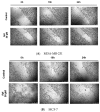Apigenin's Modulation of Doxorubicin Efficacy in Breast Cancer
- PMID: 38893482
- PMCID: PMC11174085
- DOI: 10.3390/molecules29112603
Apigenin's Modulation of Doxorubicin Efficacy in Breast Cancer
Abstract
Apigenin, a naturally derived flavonoid, is increasingly being acknowledged for its potential therapeutic applications, especially in oncology. This research explores apigenin's capacity to modulate cancer cell viability, emphasizing its roles beyond its minimal antioxidant activity attributed to its basic molecular structure devoid of hydroxyl groups. We investigated apigenin's effects on two breast cancer cell lines, estrogen-dependent MCF-7 and non-estrogen-dependent MDA-MB-231 cells. Our findings reveal that apigenin exerts a dose-dependent cytotoxic and anti-migratory impact on these cells. Interestingly, both apigenin and doxorubicin-a standard chemotherapeutic agent-induced lipid droplet accumulation in a dose-dependent manner in MDA-MB-231 cells. This phenomenon was absent in MCF-7 cells and not evident when doxorubicin and apigenin were used concurrently, suggesting distinct cellular responses to these treatments that imply that their synergistic effects might be mediated through mechanisms unrelated to lipid metabolism. A further chemoinformatics analysis indicated that apigenin and doxorubicin might interact primarily at the level of ATP-binding cassette (ABC) transporter proteins, with potential indirect influences from the AKT and MYC signaling pathways. These results highlight the importance of understanding the nuanced interactions between apigenin and conventional chemotherapeutic drugs, as they could lead to more effective strategies for cancer treatment. This study underscores apigenin's potential as a modulator of cancer cell dynamics through mechanisms independent of its direct antioxidant effects, thereby contributing to the development of flavonoid-based adjunct therapies in cancer management.
Keywords: anticancer; breast cancer treatment; flavonoids; nutrition; synergistic effects.
Conflict of interest statement
The authors declare no conflicts of interests.
Figures








Similar articles
-
Activity of the dietary flavonoid, apigenin, against multidrug-resistant tumor cells as determined by pharmacogenomics and molecular docking.J Nutr Biochem. 2015 Jan;26(1):44-56. doi: 10.1016/j.jnutbio.2014.09.008. Epub 2014 Oct 13. J Nutr Biochem. 2015. PMID: 25459885
-
Apigenin alleviates resistance to doxorubicin in breast cancer cells by acting on the JAK/STAT signaling pathway.Mol Biol Rep. 2022 Sep;49(9):8777-8784. doi: 10.1007/s11033-022-07727-0. Epub 2022 Jul 8. Mol Biol Rep. 2022. PMID: 35804214
-
Apigenin's Therapeutic Potential Against Viral Infection.Front Biosci (Landmark Ed). 2023 Oct 17;28(10):237. doi: 10.31083/j.fbl2810237. Front Biosci (Landmark Ed). 2023. PMID: 37919082 Review.
-
Acyl-CoA synthetase-4 is implicated in drug resistance in breast cancer cell lines involving the regulation of energy-dependent transporter expression.Biochem Pharmacol. 2019 Jan;159:52-63. doi: 10.1016/j.bcp.2018.11.005. Epub 2018 Nov 9. Biochem Pharmacol. 2019. PMID: 30414939
-
The influence of apigenin on cellular responses to radiation: From protection to sensitization.Biofactors. 2025 Jan-Feb;51(1):e2113. doi: 10.1002/biof.2113. Epub 2024 Aug 12. Biofactors. 2025. PMID: 39134426 Review.
Cited by
-
Effects of Cannabidiol (CBD) on Doxorubicin-Induced Anxiety and Depression-like Behaviors and mRNA Expression of Inflammatory Markers in Rats.Brain Sci. 2024 Sep 30;14(10):999. doi: 10.3390/brainsci14100999. Brain Sci. 2024. PMID: 39452013 Free PMC article.
-
Unravelling the potency of the 4-oxo-2-thioxo-1,2,3,4-tetrahydropyrimidine-5-carbonitrile scaffold with S-arylamide hybrids as PIM-1 kinase inhibitors: synthesis, biological activity and in silico studies.RSC Med Chem. 2025 Mar 28. doi: 10.1039/d5md00021a. Online ahead of print. RSC Med Chem. 2025. PMID: 40162200 Free PMC article.
-
The effect of flavonoids on the doxorubicin efficacy in cancer treatment.Naunyn Schmiedebergs Arch Pharmacol. 2025 Jun 2. doi: 10.1007/s00210-025-04312-7. Online ahead of print. Naunyn Schmiedebergs Arch Pharmacol. 2025. PMID: 40455233 Review.
-
Targeting Molecular Pathways in Breast Cancer Using Plant-Derived Bioactive Compounds: A Comprehensive Review.J Exp Pharmacol. 2025 Jun 22;17:375-401. doi: 10.2147/JEP.S528132. eCollection 2025. J Exp Pharmacol. 2025. PMID: 40585862 Free PMC article. Review.
-
Molecular Mechanisms of Lobelia nummularia Extract in Breast Cancer: Targeting EGFR/TP53 and PI3K-AKT-mTOR Signaling via ROS-Mediated Apoptosis.Curr Issues Mol Biol. 2025 Jul 14;47(7):546. doi: 10.3390/cimb47070546. Curr Issues Mol Biol. 2025. PMID: 40729015 Free PMC article.
References
-
- Ashrafizadeh M., Bakhoda M.R., Bahmanpour Z., Ilkhani K., Zarrabi A., Makvandi P., Khan H., Mazaheri S., Darvish M., Mirzaei H. Apigenin as Tumor Suppressor in Cancers: Biotherapeutic Activity, Nanodelivery, and Mechanisms With Emphasis on Pancreatic Cancer. Front. Chem. 2020;8:829. doi: 10.3389/fchem.2020.00829. - DOI - PMC - PubMed
-
- Mushtaq Z., Sadeer N.B., Hussain M., Mahwish, Alsagaby S.A., Imran M., Mumtaz T., Umar M., Tauseef A., Al Abdulmonem W., et al. Therapeutical Properties of Apigenin: A Review on the Experimental Evidence and Basic Mechanisms. Int. J. Food Prop. 2023;26:1914–1939. doi: 10.1080/10942912.2023.2236329. - DOI
-
- Pogorzelska A., Mazur M., Świtalska M., Wietrzyk J., Sigorski D., Fronczyk K., Wiktorska K. Anticancer Effect and Safety of Doxorubicin and Nutraceutical Sulforaphane Liposomal Formulation in Triple-Negative Breast Cancer (TNBC) Animal Model. Biomed. Pharmacother. 2023;161:114490. doi: 10.1016/j.biopha.2023.114490. - DOI - PubMed
MeSH terms
Substances
Grants and funding
LinkOut - more resources
Full Text Sources
Medical
Miscellaneous

